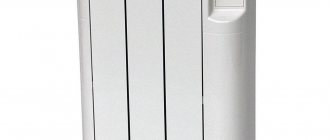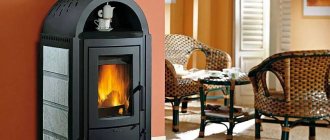Just a few years ago, your own fireplace was still considered a luxury, which was more suitable for a private home than for an ordinary city apartment. However, the production of biological fuel for fireplaces has expanded the possibilities for installing such devices. Now you can enjoy the sight of a fire right in your home, all thanks to biofuel.
Biofuel kit for eco-fireplace operation
Ecological fuel
The name “biofuel” clearly reflects the concept of this product, created exclusively from biological raw materials. Biological raw materials mean fuel created in the process of processing waste products of vital activity of organisms, which can be of animal or plant origin. It is the prefix “bio” that confirms that plant raw materials were used in the fuel production process, which means the product is completely environmentally friendly.
It is believed that biofuel for a fireplace is one of the best types of fuel, which potentially does not even require a chimney. It is this fuel that is used to fire eco-fireplaces.
It is noteworthy that biofuel for fireplaces is denatured ethanol, created from simple ethanol in production. Ethanol is nothing more than alcohol obtained from sugar-rich plant materials, such as sugar cane, wheat, beets, and potatoes. Some types of fuel are created from alcohol obtained from cellulose raw materials and wood. Alcohol is obtained through the hydrolysis of cellulose.
Since pure alcohol is not allowed for sale, biofuel for biofireplaces and conventional models is created on the basis of denatured ethanol. Thus, we can conclude that the composition of biofuel is based on ordinary alcohol.
2. Does the bio-fireplace smell? Scent or stink?
“We’ll buy biofuel, and then we’ll suffocate from the suffocating fumes...” is a very common misconception among buyers of biofireplaces. Our company Kronco carefully approached the coverage of this issue and tested each sample, as they say, on itself. You can watch in more detail in our video, where we clearly presented everything.
Now let’s briefly tell you that the smell of the purchased fuel depends solely on the composition, on the impurities that are added. But, one way or another, all this is alcohol, and therefore the smell of alcohol is present. When recording our review, it was found that samples No. 1 “ZeFire” and No. 4 “Profit” have a specific aroma similar to tequila. The rest of the options presented have the smell of pure alcohol.
Main properties and features
During the production of biological fuel, ethanol is denatured, making it neutral and safe for humans, animals and other organisms. When burned, it easily decomposes, producing carbon monoxide, some steam and, of course, heat.
At the same time, the outlines of the fire are quite colorful, the flames are even, bright, and saturated in color. The color of the flame is, of course, a little different from normal, it is not as orange, since burning ethanol releases carbon dioxide and water. To get a more natural fire, natural, environmentally friendly additives are added to liquid fuel for fireplaces, which color the fire the desired orange color.
During combustion, environmentally friendly biofuel on bioethanol does not emit smoke or soot, the process is odorless and does not annoy us with any unpleasant aroma. It is for this reason that a biofuel fireplace does not need a chimney or hood.
But what’s even better is that the heat generated during combustion is not lost, but is completely released into the room. Thus, the efficiency of such an installation reaches 95-100%. At the same time, in terms of the type of flame, ecofuel for fireplaces is not much different from ordinary firewood, which allows you to see a real fire. A fireplace gel based on ethanol with the addition of sea salt allows you to create the complete illusion of burning real wood, since in addition to a similar fire, a characteristic sound will appear in the form of crackling.
Good to know: Famous brands of biofireplaces: Polish Kratky, Australian Planika
A biofuel fireplace during its operation, as we have already said, practically does not emit soot and soot. Experts compare its emissions into the indoor atmosphere with the burning of one ordinary candle. At the same time, the bio-fireplace liquid does not emit carbon monoxide during combustion, which can be dangerous in large volumes.
Bioethanol used for fireplaces can also be poured into a regular kerosene lamp. In this case, during combustion there will be no soot and odor emitted, as when burning kerosene, and the device will perform its original functionality perfectly, illuminating the room.
Electric fireplaces
When talking about the absence of a chimney, many often mean the absence of any pipe as such. Until recently, it was believed that stoves without a chimney were a pipe dream. Today there are at least three ways to make this dream come true:
- electric fireplaces;
- biofireplaces;
- tiled stoves.
The most popular is the use of electric fireplaces. This option is suitable for a summer cottage, since you don’t have to count on a large heated area, and electricity can handle heating a small house. The heating element in such a stove is a nichrome spiral, which is placed in an insulated housing. The effect of heat transfer from such stoves is enhanced by the arrangement of convection channels in which the air is effectively heated and enters the room.
Electric fireplace option
Electric fireplaces do not require chimneys, with the exception of a dummy when creating a certain style. They simulate flames using a variety of technologies. The flame based on the work of a steam generator is a real miracle, as it is pleasant to admire, and the three-dimensional image conveys all the magical power of living fire. Electric fireplaces or heaters are the only possible heat source for the garage. Even installing a conventional solid fuel stove is difficult, as it takes up precious space.
Types of biological fuels
Conventionally, all produced biological fuel for fireplaces can be divided into three groups:
- Bioethanol, denatured alcohol with some additives to make fire realistic.
- Biodiesel fuel produced from vegetable oils.
- Biogas fuel produced from human waste and considered an analogue of natural gas. Used mainly for industrial purposes.
Biofuel is produced all over the world: in Europe, America, Asia and even Africa. Currently, the main supplier of such products is Brazil. Let's look at biofireplace fuel in more detail:
- Bioethanol, which looks like a colorless, odorless liquid, is created on the basis of alcohol. Alcohol for creating fuel is obtained from carbohydrates found in sugar, which is the key to the naturalness of the product. Sugar is extracted from cane, potatoes, beets, and corn. Ethanol can be produced from wood raw materials that contain cellulose.
- Biodiesel fuel, like bioethanol, is a safe and clean product; when released into water, it does not harm other organisms or the environment. This fuel is created from vegetable and animal fats, which can be obtained from coconut, soybean, and palm oils. In Europe, almost every liquid fuel fireplace uses biodiesel.
Biofuels produced in Switzerland
When choosing biofuel for use in a fireplace, pay attention to the certification documentation, and then to the level of thermal performance of the fuel, a description of the color of the flame, its sharpness and sound. After all, you chose a bio-fireplace to be able to see a real fire at home, which is safe for you and the environment.
Good to know: Well-known foreign and domestic manufacturers of biofireplaces
Review of popular brands
Biodiesel for automobiles is mainly produced in America (USA, Canada and Brazil), as well as India, China and Europe. This is often presented as concern for the environment and increased use of alternative energy sources.
But there is one caveat - to produce large volumes of biodiesel, large volumes of organic matter (corn, rapeseed, sugar cane) are required. However, large-scale cultivation of these crops consumes a lot of water and, again, fuel for agricultural machinery.
The output result is quite ambiguous. It’s one thing when waste is processed to make such fuel, and quite another thing is the processing of plants specially grown for this purpose.
The main ingredient of all brands of biofuel for fireplaces is alcohol; it does not have any particular differences in quality and composition between different manufacturers (+)
The situation with ethanol biofuel is somewhat different. It is produced on a much smaller scale. This is mainly done in Europe, but Russia also has its own factories. To produce this biofuel, raw materials of plant origin are also needed, but not in such huge volumes as in the case of the automobile analogue.
In domestic stores, you can choose fireplace biofuel from the following brands:
- Kratki BioDECO (Poland).
- InterFlame (Russia).
- BioKer (Russia).
- Planika Fanola (Germany).
- Vegeflame (France).
- Bionlov (Switzerland).
- Bioteplo Slimfire (Italy).
The choice is quite extensive. The price per liter ranges from 260–600 rubles. Cost often depends on the presence/absence and combination of additional additives. Some aromatic oils are quite expensive. Although they are present in biofuels in very small proportions, they still affect the price.
Advantages and disadvantages
Like any other product, biofuels have their pros and cons. In particular, all owners of biofireplaces are very interested in data on the consumption and efficiency of such fuel.
If we consider modern models of fireplaces, then half a liter of liquid per hour is enough for their full operation. Gel biofuel for fireplaces takes a little longer to consume. When burning half a liter of fuel, the energy released is approximately 3-3.5 kW/h.
The operation of a liquid fuel fireplace in terms of heat transfer can be compared with a 3 kW heater, only unlike an electric appliance, a biofireplace does not dry the air, but rather humidifies it.
We have summarized other advantages of biological fuel into a short list:
- Environmentally friendly biofuel does not emit harmful substances, burning, soot, soot, smoke or other gases into the air during combustion.
- Fireplaces for apartments using biofuel do not require the installation of a hood or chimney, since they are simply not needed.
- Since there is no chimney or exhaust hood, all the heat enters the room. Additionally, the air in the room is humidified, because When burning, water vapor is released.
- Bio-fireplace burners from biological fuel practically do not get dirty, and small stains are easy to clean.
- The level of liquid combustion in the fireplace can be adjusted, this is especially easy with a gel composition.
- Biological fireplaces are considered fireproof devices because they have a thermally insulated body. The installation of such devices is simple; they are easy to assemble and disassemble.
- Unlike firewood, biofuel does not leave behind any waste and can be purchased at any time. In addition, the price for this type of fuel is quite affordable.
There are also disadvantages, but they are few:
- Biological fuel must not be added to the fireplace while it is operating. To replenish supplies, you should extinguish the flame, wait for the fireplace elements to cool, and then refuel.
- Biofuel is a flammable composition, so it should not be stored near fire or hot objects.
- Biological fuel is ignited with a special lighter made of iron; it is not permissible to use paper or firewood for ignition.
Popular biofuel brands
Using biological fuel in a fireplace is extremely simple; just pour the liquid into a special fuel tank and then set it on fire. It is extremely difficult to fill in more liquid than the fireplace needs, since the fuel canister has a consumption scale, and the fuel block for a biofireplace is made of a certain size. Usually a 5 liter canister is enough for 19-20 hours of fireplace operation.
Good to know: Using bio-fireplaces in an apartment as decoration and a heat source
If the bio-fireplace uses a gel composition, then just print out the jar, place it in a special place in the fireplace behind decorative firewood or stones and set it on fire. One can of gel fuel burns for approximately 2.5-3 hours. You can use multiple cans to increase the flame. To put out a fire in jars, simply close them with lids, cutting off the access of oxygen to the fire.
Rules for working with ecofuels
It is not recommended to ignite biological fuel with paper and logs; special iron lighters are used for this.
Some people believe that biofireplaces are easy to use. Units running on biofuel are fireproof. But manufacturers recommend taking the following precautions:
- The fireplace burner must be completely cool before use.
- Eco-fuel cannot be filled to the brim. The metal container is filled only one third.
- There should be no sources of fire near the fireplace.
- To ignite, you need to use a long lighter, which comes with the bio-fireplace.
- Do not add liquid while the fireplace is running. First you need to put it out, and then add it.
- Bioethanol must not be lit with paper or wood.
- Do not add a lot of essential oil to the fuel.
- After use, the remaining liquid must be drained. It is not reused.
- If biofuel gets on the floor or other surfaces, you must immediately wipe the area dry.
- In case of contact with skin, wash the affected areas under running water and soap.
- The container with the product should be kept away from the fireplace.
- Children and pets should not be allowed near the fuel.
Eco-fuel is produced in cans, from which it cannot be poured into other containers, as this is dangerous. It is prohibited to dilute bioethanol with kerosene or other flammable mixtures. If a person has diseases of the respiratory system, before purchasing a biofireplace for home, you should consult a doctor.
How to make biofuel yourself
It is noteworthy that you can make biofuel for the fireplace with your own hands directly at home. To do this you will need:
- 96% ethanol, sold in pharmacies. Unfortunately, you won’t be able to make bioethanol for a fireplace with your own hands.
- Gasoline of high purity, for coloring the flame, which is used to refill lighters. It is desirable that the gasoline has no odor and is completely transparent in color.
The ingredients must be mixed in the following proportion: per 1 liter of ethanol, approximately 50-100 ml of gasoline. Then the resulting composition must be thoroughly mixed and poured into the fireplace. It is advisable to make fuel for a biofireplace with your own hands immediately before use, since the substances may separate from long-term storage.
Smokeless fuel for fireplaces can be used in rooms where there is no special chimney or ventilation, that is, in almost any apartment, house, office, or country house. At the same time, you can enjoy a real fire right in your home, because this fuel is suitable for almost all types of interior fireplaces.
DIY bioethanol
If it is not possible to purchase biofuel, but you want to warm up by a biofireplace, then you can make fuel for it yourself. However, it should be remembered that this is only a temporary measure that should be resorted to in exceptional cases.
You need to start with preparation.
To protect yourself and your interior items from damage, you need to remove the carpet from the floor and cover the surface itself with unnecessary rags or newspapers. It is also necessary to take care of the skin of your hands and eyes. To do this, wear gloves and safety glasses.
For homemade fireplace fuel you will need:
- medical alcohol 90-96.6 degrees;
- fuel for Zippo lighters (gasoline);
- mixing container;
- measuring cup;
- lighter.
Both components are mixed so that the percentage of gasoline in the volume of finished fuel is 6-10%. If it is not possible to calculate the required percentage, then you can do differently. To one part gasoline, take 9 parts alcohol and mix. The finished composition is poured into cups and set on fire. A temporary drawback of such a mixture is the smell of alcohol in the first minutes of combustion, which then disappears. Fuel consumption for a biofireplace: 100 ml per 1 hour of burning.
Manufacturing procedure
First you need to think about the design of the burner. To do this, you can use a simple tin can, into which fuel will subsequently be poured. To create a uniform flame, it is recommended to use a wick made from natural materials - hemp or jute.
Biofireplace body
Wooden or steel sheets can be used as manufacturing material. The latter option is preferable, as it is safer to use. Then a lattice platform is installed on the top of the structure. It will serve as a base for the stones. They are a decorative part of the bio-fireplace and do not perform any functions.
Lattice example
To give a better appearance, you can install additional glass walls. They will protect the flame from drafts, which will significantly increase the safety of the entire device.
The jar with the prepared fuel is placed on the bottom of the bio-fireplace, the wick is brought out through the holes in the grate. After filling the layer of stones, it should remain in the visible part. A similar model can be installed on a coffee table or chest of drawers.
If desired, you can make a complete imitation of a fireplace. To do this, you must first draw up a drawing of the decorative design. Most often, its shape and size correspond to real fireplaces. The differences lie in the materials used. For this purpose, drywall and profiles for it are used.
Fireplace drawing. Clickable
The procedure for its manufacture consists of the following steps:
Drawing up a drawing. It depends on the location - in the corner of the room or against one of the walls. Determining optimal sizes
It is important to know that the dimensions of the combustion chamber are not a significant parameter. Those
in fact, you can make it small in height. The only limitation is the flame from the bio-fireplace - it should not heat the upper surface of the firebox. Installation of the finished burner. This is carried out only after the final finishing of the fireplace.
This design will not heat the room, but serves only as a unique interior detail.
Recommendations for use
Biofuel Firebird AROMA Vanilla
Bioethanol, which is part of environmental fuel, is considered a highly flammable substance. When using it, you must follow some safety rules:
- Under no circumstances should the substance be added to an open flame or fuel tank that has not yet cooled down. Before refueling the bio-fireplace, you need to turn off the device and wait for it to cool completely (takes about 15 minutes).
- Do not use flammable materials such as paper, dry grass, or wood for ignition. You can only use a special long metal lighter, electric ignition or a long match.
- Do not store the fuel canister near a working fireplace or other source of open flame.
- It is recommended to keep biofuel for biofireplaces away from children.
- If the substance is spilled, you need to wipe it well with an absorbent cloth.
Manufacturers
Fuel for biofireplaces is produced in Europe (specifically Italy, Germany, France, Spain), North and South America (specifically Canada, Brazil, USA). The undisputed leader in ethanol production is Brazil. Biofuels produced in South Africa are popular in Africa. About 5% of biofuels are produced in China and India.
Biofuel producers
| Manufacturing company | Characteristic |
| Fanola | This is a high quality liquid for bio-fireplaces. Combustion of 1 liter of substance produces 5.6 kW of energy. The burning time is from 2.5 to 5 hours. Safety tested and certified. The cost varies between 300-400 rubles per 1 liter. |
| Vegeflame | Ecological fuel. Available in large volume containers of 5 and 20 liters. Average biofuel consumption is 0.3 l/hour. 20 liters of biofuel is enough for 68-72 hours of continuous burning. The cost of 20 liters of fuel is about 5,200 rubles. Price for 5 liters - 1400 rubles. |
| Kratki | Available in 1 liter bottles. There are varieties with a flavored component: coffee, forest, etc., as well as with different flame colors (ripe cherry). High quality ethanol is used for production. The operating time on one bottle varies from 2 to 5 hours. The cost of 1 liter of Kratki is 580–1,500 rubles. The Kratki “Premi” variety can be purchased at a price of 350 rubles for 1.5 liters. |
| InterFlame | Available in 1 liter plastic bottles. There are assorted varieties with different flame colors. When 1 liter of substance is burned, 3 kW of heat energy is released. The cost of 1 liter of InterFlame is from 350 rubles. |
You can read about biofireplaces from the Polish company Kratki here.
Step-by-step instruction
There are several options available to the home craftsman who cares about the beauty of his home.
Method one is the simplest
The box will be glass:
Prepare 4 parts to assemble a rectangular structure. They should be secured together with silicone sealant. There is no need to make a rectangle that is too narrow - this way it will heat up faster and transfer heat to the surrounding space, if this is not provided for in your plans; When using a metal mug, make sure to have a lid in which you drill a hole for the wick and flame outlet. The lid can then be used to extinguish the fire of the flame; The fuel mixture tank should be properly strengthened so that it does not wobble or tilt. You can cover it with decorative stone, fragments of bricks, glass balls, and additional decoration may no longer be required; To fasten a glass box, it is best to use a strong and reliable base where the structure will be installed, for example, it can be decorative ceramic, forged metal or glass; Cover with the finished box, pour in ethyl alcohol and set it on fire.
Please note that the hand with the lighter should be at a decent distance from the burner to prevent clothing from catching fire.
Method 2 - monumental
We will make the floor structure:
- According to the selected drawing, we prepare a frame from plasterboard sheets;
- To insulate it from fire, it is covered with fire-resistant roll material, we previously mentioned isover, it copes well with its protective purposes not only as a fire-fighting material, but also as a decorative material: with various imitation of wood or brick;
- The front side can be lined with tiles, covered with white or colored plaster, and covered with non-flammable wallpaper;
- The firebox of an open bio-fireplace can be equipped in both open and closed versions, but for the second case a separate glass door is needed











